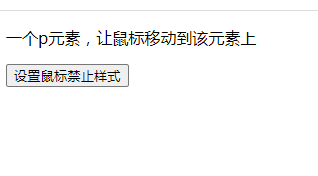How to use CSS() to set the mouse prohibition style in jquery
Method: Just use CSS() to set the value of the mouse style attribute "cursor" to "not-allowed". The syntax is "element object.css("cursor","not-allowed" )" or "element.css({"cursor":"not-allowed"})".

The operating environment of this tutorial: windows7 system, jquery1.10.2 version, Dell G3 computer.
If you want to set the mouse prohibition style, just use the cursor attribute.
Just use CSS() to set the value of the mouse style attribute "cursor" to "not-allowed".
There are two setting syntaxes:
元素对象.css("cursor","not-allowed")
元素对象.css({"cursor":"not-allowed"})Implementation example:
<!DOCTYPE html>
<html>
<head>
<meta charset="UTF-8">
<script src="js/jquery-1.10.2.min.js"></script>
<script type="text/javascript">
$(document).ready(function() {
$("button").click(function() {
// $("p").css("cursor","not-allowed");
$("p").css({"cursor":"not-allowed"});
});
});
</script>
</head>
<body>
<p>一个p元素,让鼠标移动到该元素上</p>
<button>设置鼠标禁止样式</button>
</body>
</html>
Instructions:
The cursor attribute defines the cursor shape used when the mouse pointer is placed within the bounds of an element.
When the attribute value of the cursor attribute is "not-allowed", the mouse cursor shape is a prohibited pattern.
The cursor attribute has the following values. The default value is default
| ##crosshair; | crosshair Heart | The cursor appears as a crosshair | ||
| cursor: hand; #Write two to take care of IE5, which only recognizes hand. |
The cursor indicates a connection in the form of a hint (finger) | |||
| Wait/Hourglass | The cursor indicates that the current program is busy (usually A watch or an hourglass) | |||
| help | The cursor indicates that help is available at the current location (usually a question mark or a balloon) | ##cursor: no-drop; | ||
Unable to release |
cursor: no-drop; |
##cursor: text; | ||
| Text/Edit | The cursor indicates that the current position is the text content | cursor: move; | ||
| Moveable objects | The cursor implies that something should be moved | cursor: n-resize; | ||
| Change size upward (North) | Edge can move upward (North) | cursor: s-resize; | ||
| Change size downward (South) | The edge can move downward (south) | cursor: e-resize; | ||
| Toward Right change size (East) | The edge of the box can be moved to the right (East) | cursor: w- resize; | ||
| Change the size to the left (West) | The edge can be moved to the left (West) | cursor: ne-resize; | ||
| Change size up and to the right (North East) | Cursor hint box The edge can be moved to the upper right (northeast direction) | cursor: nw-resize; | Change the size up and left (North West) |
The edge can be moved up and left (North West) |
cursor: se-resize; |
Change size down to the right (South East) |
The edge can be down to the right Move (Southeast) |
||
| ##cursor: sw-resize; | Change size down and left (South West) | The edge can move to the lower left (southwest) | ||
| Automatic | The browser sets a cursor | |||
| forbidden | cursor:not-allowed; | |||
| Processing | cursor: progress; | |||
| System default | Default cursor state (usually an arrow) | |||
|
|
Customize the url position of the cursor | Note: Customize after defining Add a general cursor at the end after the cursor, in case the cursor defined by the url cannot be used |
jQuery video tutorial
,web front-end development]
The above is the detailed content of How to use CSS() to set the mouse prohibition style in jquery. For more information, please follow other related articles on the PHP Chinese website!

Hot AI Tools

Undresser.AI Undress
AI-powered app for creating realistic nude photos

AI Clothes Remover
Online AI tool for removing clothes from photos.

Undress AI Tool
Undress images for free

Clothoff.io
AI clothes remover

Video Face Swap
Swap faces in any video effortlessly with our completely free AI face swap tool!

Hot Article

Hot Tools

Notepad++7.3.1
Easy-to-use and free code editor

SublimeText3 Chinese version
Chinese version, very easy to use

Zend Studio 13.0.1
Powerful PHP integrated development environment

Dreamweaver CS6
Visual web development tools

SublimeText3 Mac version
God-level code editing software (SublimeText3)

Hot Topics
 1655
1655
 14
14
 1413
1413
 52
52
 1306
1306
 25
25
 1252
1252
 29
29
 1226
1226
 24
24
 Detailed explanation of jQuery reference methods: Quick start guide
Feb 27, 2024 pm 06:45 PM
Detailed explanation of jQuery reference methods: Quick start guide
Feb 27, 2024 pm 06:45 PM
Detailed explanation of jQuery reference method: Quick start guide jQuery is a popular JavaScript library that is widely used in website development. It simplifies JavaScript programming and provides developers with rich functions and features. This article will introduce jQuery's reference method in detail and provide specific code examples to help readers get started quickly. Introducing jQuery First, we need to introduce the jQuery library into the HTML file. It can be introduced through a CDN link or downloaded
 How to use PUT request method in jQuery?
Feb 28, 2024 pm 03:12 PM
How to use PUT request method in jQuery?
Feb 28, 2024 pm 03:12 PM
How to use PUT request method in jQuery? In jQuery, the method of sending a PUT request is similar to sending other types of requests, but you need to pay attention to some details and parameter settings. PUT requests are typically used to update resources, such as updating data in a database or updating files on the server. The following is a specific code example using the PUT request method in jQuery. First, make sure you include the jQuery library file, then you can send a PUT request via: $.ajax({u
 In-depth analysis: jQuery's advantages and disadvantages
Feb 27, 2024 pm 05:18 PM
In-depth analysis: jQuery's advantages and disadvantages
Feb 27, 2024 pm 05:18 PM
jQuery is a fast, small, feature-rich JavaScript library widely used in front-end development. Since its release in 2006, jQuery has become one of the tools of choice for many developers, but in practical applications, it also has some advantages and disadvantages. This article will deeply analyze the advantages and disadvantages of jQuery and illustrate it with specific code examples. Advantages: 1. Concise syntax jQuery's syntax design is concise and clear, which can greatly improve the readability and writing efficiency of the code. for example,
 jQuery Tips: Quickly modify the text of all a tags on the page
Feb 28, 2024 pm 09:06 PM
jQuery Tips: Quickly modify the text of all a tags on the page
Feb 28, 2024 pm 09:06 PM
Title: jQuery Tips: Quickly modify the text of all a tags on the page In web development, we often need to modify and operate elements on the page. When using jQuery, sometimes you need to modify the text content of all a tags in the page at once, which can save time and energy. The following will introduce how to use jQuery to quickly modify the text of all a tags on the page, and give specific code examples. First, we need to introduce the jQuery library file and ensure that the following code is introduced into the page: <
 Use jQuery to modify the text content of all a tags
Feb 28, 2024 pm 05:42 PM
Use jQuery to modify the text content of all a tags
Feb 28, 2024 pm 05:42 PM
Title: Use jQuery to modify the text content of all a tags. jQuery is a popular JavaScript library that is widely used to handle DOM operations. In web development, we often encounter the need to modify the text content of the link tag (a tag) on the page. This article will explain how to use jQuery to achieve this goal, and provide specific code examples. First, we need to introduce the jQuery library into the page. Add the following code in the HTML file:
 How to remove the height attribute of an element with jQuery?
Feb 28, 2024 am 08:39 AM
How to remove the height attribute of an element with jQuery?
Feb 28, 2024 am 08:39 AM
How to remove the height attribute of an element with jQuery? In front-end development, we often encounter the need to manipulate the height attributes of elements. Sometimes, we may need to dynamically change the height of an element, and sometimes we need to remove the height attribute of an element. This article will introduce how to use jQuery to remove the height attribute of an element and provide specific code examples. Before using jQuery to operate the height attribute, we first need to understand the height attribute in CSS. The height attribute is used to set the height of an element
 Understand the role and application scenarios of eq in jQuery
Feb 28, 2024 pm 01:15 PM
Understand the role and application scenarios of eq in jQuery
Feb 28, 2024 pm 01:15 PM
jQuery is a popular JavaScript library that is widely used to handle DOM manipulation and event handling in web pages. In jQuery, the eq() method is used to select elements at a specified index position. The specific usage and application scenarios are as follows. In jQuery, the eq() method selects the element at a specified index position. Index positions start counting from 0, i.e. the index of the first element is 0, the index of the second element is 1, and so on. The syntax of the eq() method is as follows: $("s
 How to tell if a jQuery element has a specific attribute?
Feb 29, 2024 am 09:03 AM
How to tell if a jQuery element has a specific attribute?
Feb 29, 2024 am 09:03 AM
How to tell if a jQuery element has a specific attribute? When using jQuery to operate DOM elements, you often encounter situations where you need to determine whether an element has a specific attribute. In this case, we can easily implement this function with the help of the methods provided by jQuery. The following will introduce two commonly used methods to determine whether a jQuery element has specific attributes, and attach specific code examples. Method 1: Use the attr() method and typeof operator // to determine whether the element has a specific attribute




